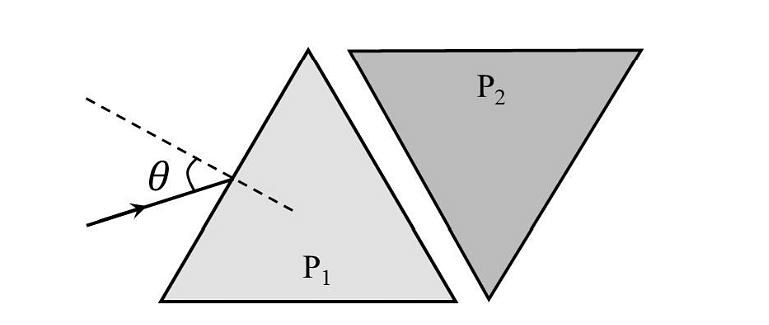Question:
Consider an expanding sphere of instantaneous radius
Consider an expanding sphere of instantaneous radius
Updated On: Jun 14, 2022
- $R$
- $R^{3}$
- $\frac{1}{R}$
- $R^{2/3}$
Hide Solution
Verified By Collegedunia
The Correct Option is A
Solution and Explanation
$m =\rho \frac{4}{3} \pi R ^{3}$
$0=\rho \cdot 4 \pi R ^{2} \frac{ dR }{ dt }+\frac{4}{3} \pi R ^{3} \frac{ d \rho}{ dt }$
$-\frac{1}{\rho} \frac{ d \rho}{ dt }=\frac{3}{ R } \frac{ dR }{ dt }$
$-\frac{ R }{3} \frac{1}{\rho} \frac{ d \rho}{ dt }=\frac{ dR }{ dt }$
$\frac{ dR }{ dt } \propto R$
$v \propto R$
$0=\rho \cdot 4 \pi R ^{2} \frac{ dR }{ dt }+\frac{4}{3} \pi R ^{3} \frac{ d \rho}{ dt }$
$-\frac{1}{\rho} \frac{ d \rho}{ dt }=\frac{3}{ R } \frac{ dR }{ dt }$
$-\frac{ R }{3} \frac{1}{\rho} \frac{ d \rho}{ dt }=\frac{ dR }{ dt }$
$\frac{ dR }{ dt } \propto R$
$v \propto R$
Was this answer helpful?
0
0
Top Questions on physical world
- The quantities $x=\frac{1}{\sqrt{\mu_{0} \epsilon_{0}}}, y=\frac{E}{B}$ and $z =\frac{1}{ CR }$ are defined where C - capacitance R - Resistance, l - length, E - Electric field, B - magnetic field and $\epsilon_{0}, \mu_{0},$ - free space permittivity and permeability respectively. Then :
- JEE Main - 2020
- Physics
- physical world
- Dimensional formula for thermal conductivity is (here $K$ denotes the temperature)
- JEE Main - 2020
- Physics
- physical world
- A screw gauge has $50$ divisions on its circular scale. The circular scale is $4 $ units ahead of the pitch scale marking, prior to use. Upon one complete rotation of the circular scale, a displacement of $0.5\, mm$ is noticed on the pitch scale. The nature of zero error involved, and the least count of the screw gauge, are respectively :
- JEE Main - 2020
- Physics
- physical world
- Amount of solar energy received on the earth's surface per unit area per unit time is defined a solar constant. Dimension of solar constant is:
- JEE Main - 2020
- Physics
- physical world
- If momentum $ (P)$, area $(A)$ and time $(T)$ are taken to be the fundamental quantities then the dimensional formula for energy is :
- JEE Main - 2020
- Physics
- physical world
View More Questions
Questions Asked in JEE Advanced exam
- Let \(S=\left\{\begin{pmatrix} 0 & 1 & c \\ 1 & a & d\\ 1 & b & e \end{pmatrix}:a,b,c,d,e\in\left\{0,1\right\}\ \text{and} |A|\in \left\{-1,1\right\}\right\}\), where |A| denotes the determinant of A. Then the number of elements in S is _______.
- JEE Advanced - 2024
- Matrices
- A block of mass \(5 kg\) moves along the \(x-\)direction subject to the force \(F = (−20x + 10) N,\) with the value of \(x \) in metre. At time \(t = 0 s,\) it is at rest at position \(x = 1 m\). The position and momentum of the block at \(t = (\pi/4)\) s are
- JEE Advanced - 2024
- Work-energy theorem
- Two equilateral-triangular prisms \(P_1 \)and \(P_2\) are kept with their sides parallel to each other, in vacuum, as shown in the figure. A light ray enters prism \(P_1\) at an angle of incidence 𝜃 such that the outgoing ray undergoes minimum deviation in prism \(P_2\). If the respective refractive indices of \(P_1\) and\( P_2\) are \(√ 3 /2\) and \(√3\), then \(\theta = sin{−1}[\sqrt \frac{ 3}{ 2} sin ( \frac{\pi}{B} )],\) where the value of \(\beta\) is ______.

- JEE Advanced - 2024
- Ray optics and optical instruments
- Let \(\overrightarrow{OP}=\frac{\alpha-1}{\alpha}\hat{i}+\hat{j}+\hat{k},\overrightarrow{OQ}=\hat{i}+\frac{\beta-1}{\beta}\hat{j}+\hat{k}\) and \(\overrightarrow{OR}=\hat{i}+\hat{j}+\frac{1}{2}\hat{k}\) be three vector where α, β ∈ R - {0} and 0 denotes the origin. If \((\overrightarrow{OP}\times\overrightarrow{OQ}).\overrightarrow{OR}=0\) and the point (α, β, 2) lies on the plane 3x + 3y - z + l = 0, then the value of l is _______.
- JEE Advanced - 2024
- Vector Algebra
- Let \(\vec{p}=2\hat{i}+\hat{j}+3\hat{k}\) and \(\vec{q}=\hat{i}-\hat{j}+\hat{k}\). If for some real numbers α, β and γ we have
\(15\hat{i}+10\hat{j}+6\hat{k}=α(2\vec{p}+\vec{q})+β(\vec{p}-2\vec{q})+γ(\vec{p}\times\vec{q})\),
then the value of γ is ________.- JEE Advanced - 2024
- Vector Algebra
View More Questions
Concepts Used:
Physical World
The physical world includes the complications of the natural world around us. It is a type of analysis of the physical world around us to understand how it works. The fundamental forces that control nature are:
- Gravitational Force is a universal force that exists as an outcome of mutual attraction between any two objects with respect to their masses.
- Electromagnetic Force can be understood as the force that is present between the charged particles. The force is stated by Coulomb’s law.
- Strong Nuclear Force is the force that ties the protons and neutrons in a nucleus. Of all the elemental forces in nature, a strong nuclear force is the strongest as its name suggests.
- Weak Nuclear Force can only be noticed in some of the nuclear processes such as the beta decay of the nucleus.



